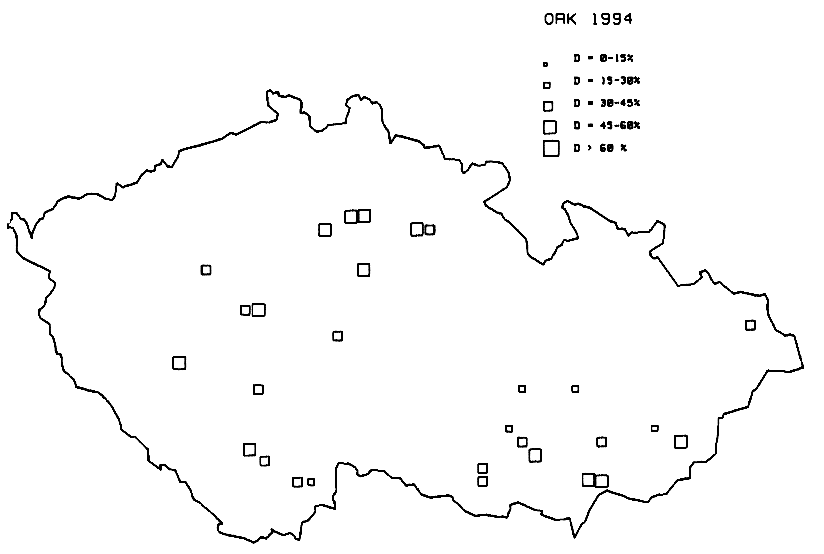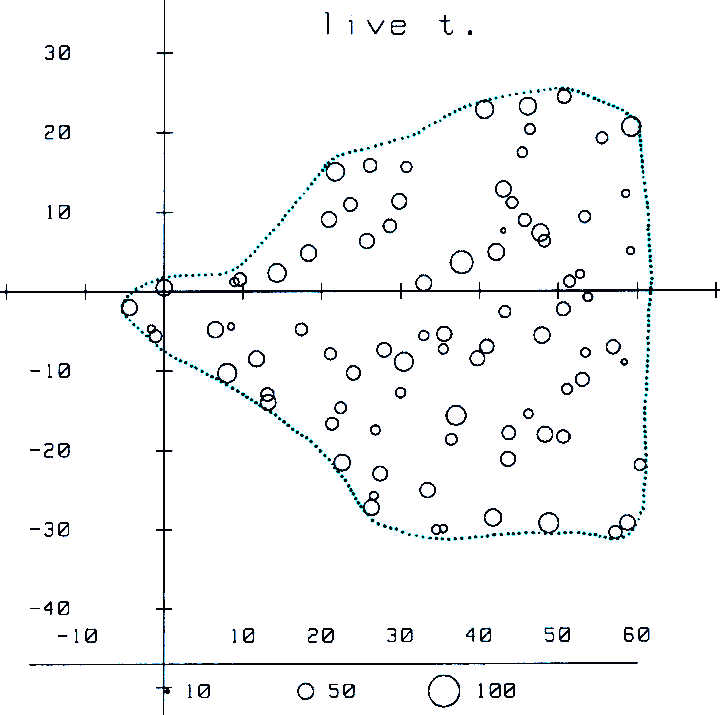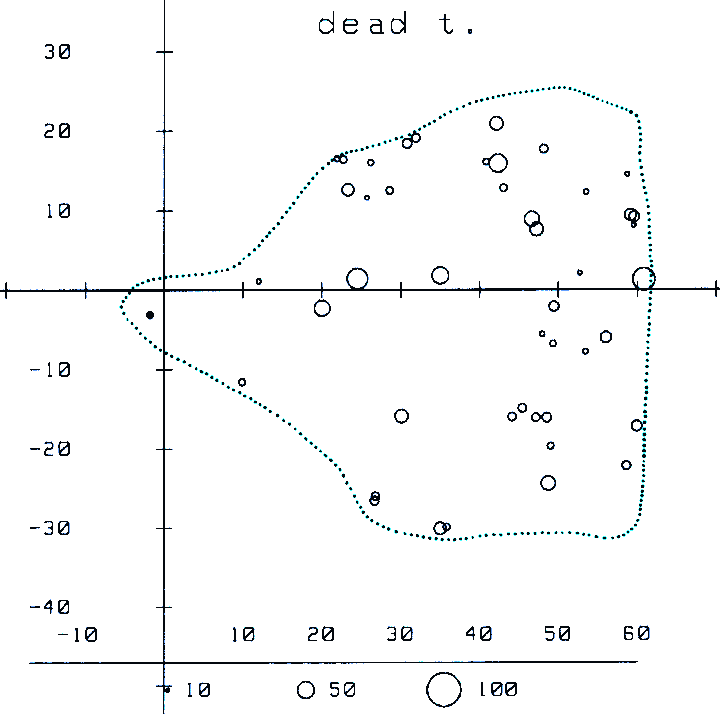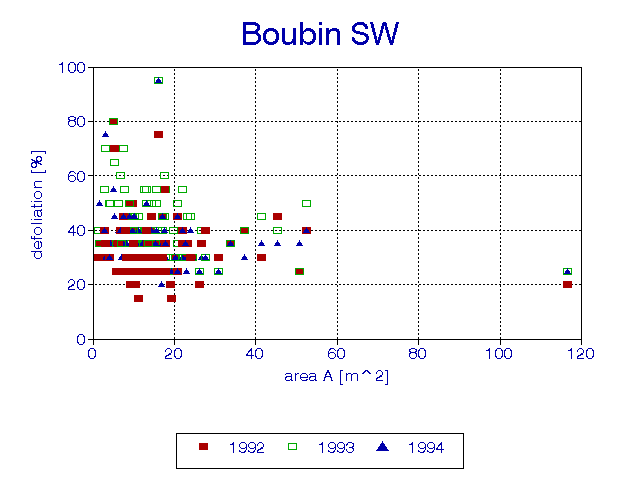
Published in K. Matějka, ed., Investigation of the Forest Ecosystems and of Forest Damage. Praha, 1995, p. 130-138
Defoliation of the Forest Trees and its Relationships to the Structure and Development of Stands
Karel Matějka
Abstract
The 1994 monitoring results of a forest assessment in the Czech Republic are described. There is no important change in the trends of the forest health state (according to defoliation) development. Most frequent values of defoliation are between 30 and 40 % by both Picea abies and Pinus sylvestris. Relations between defoliation and the stand spatial structure are evaluated using results of two Norway spruce (Picea abies) forests in the South Bohemian mountain region Šumava.
Keywords
defoliation, forest damage, health status, Picea abies, spatial structure of stand
Introduction
Development of the forest (tree) state in the Czech Republic to 1993 was published in an earlier paper (Matějka, 1994). The aim of this contribution is
Methods
Forest stands of the Czech Republic were assessed according methods of the International Co-operative Programme Assessment and Monitoring of Air Pollution Effects on Forests (ICP-Forests) (Matějka, 1993).
I mean value D - 0.5*s (where D is average defoliation of all trees in the plot and s is standard deviation of their defoliation) under the term “potential defoliation of a stand”.
Two stands in the South Bohemian region of Šumava Mts. were selected for investigation of relation processes of damage to spatial structure of the stand. First one is BOUBÍN SW. Description of the ecosystem is given in Matějka (1992). The second plot (TROJMEZÍ) is near the border of Czech Republic, Germany and Austria in the top part of Šumava Mts. Tree layer consist of Picea abies in both plots.
All trees in both plots were assessed according to defoliation (D) (each year). Height (h) and diameter in breast height (dbh) were measured periodically (one measurement was taken into account). Position of all trees including dead ones was registered.
Area of living space (A) occupied by a single tree was computed according to
A = (r1.r2.r3)2/3
where r1 is distance of a tree to the first closest neighbour, r2 is distance to second one, r3 is distance to third one. I presume that the value A may be negatively correlated with the competition pressure on the tree.
Results
Comparing years 1993 and 1994, we have observed a small shift of the Norway spruce defoliation to higher classes. The most frequent values of index of change C (see Matějka, 1994) fall into interval <0;+0.5>. The state by Pinus sylvestris L. was stabile. The oak stands showed very meaningful changes: a group of stands strength worsening another group of stands visible improving - index C varies in interval <-3.0;+3.5>. The oak defoliation varied more in 1993 than in 1994.
Picea abies (L.) KARSTEN - the most frequent tree species of the Czech Republic shows a distinction of two parts of the republic. The southwest half is with more defoliated spruce forests. The plots with average defoliation above 30% prevail there. Expected development in near future will be harmful regarding to low ratio of trees without an important defoliation indicated by high potential defoliation. A region with lot of problems exists there. It is an area in South Bohemia (South-Bohemian Basins, Novohradské hory Mts., and adjacent part of Bohemian-Moravian Upland). It is the region of the highest (potential) defoliation by Pinus sylvestris L., too. Problems occur there in relation to the chemical elements content (state of nutrition) in the Norway spruce needles (see Matějka, 1995).
The basic results arising from the observation of Norway spruce forests in Šumava region are following:
Conclusions
Processes of forest damage in the area of Czech Republic continue in the trend started on the break of ´80 and ´90. It is necessary paid attention to the development in the southwestern part of the republic, especially in region of South Bohemian Basins and Bohemian-Moravian Upland. Situation is very acute by oak.
Evaluation of the forest stand structure in a plot was used in a sere of ways with further goals:
Modelling and description of the tree layer development is possible for instance by including a probability of defoliation increase or a probability of withering away in some models.
References
Matějka, K., 1992: A case study of mountain spruce forest - problems and comments. (in Czech) In: K. Matějka, Ed., Investigation of the mountain forest ecosystems and of forest damage in the Czech Republic. České Budějovice, p. 42-50.
Matějka, K., 1993: Monitoring stavu lesů České republiky. Metodický komentář, seznam ploch a některé dosavadní výsledky. VÚLHM Jíloviště-Strnady, Praha, 68 pp.
Matějka, K., 1994: Monitoring of the forest status in the Czech Republic. Recent results and prospects. In: K. Matějka, Ed., Investigation of the forest ecosystems and of forest danage. Praha, p. 146-154.
Matějka, K., 1995a: Forest conditions under the air-pollution impact in Europe (Some results of the International Co-operative programme). Colloques Phytosociologiques, 23: 473-485.
Matějka, K., 1995b: Bioindication of nutrition state and pollution on the base of foliar analysis. In: K. Matějka, Ed., Investigation of the Forest Ecosystems and of Forest Damage. Praha, p. 95-106.
Table 1. Geographical localization of the selected plots in Šumava Mts.
|
BOUBÍN SW |
TROJMEZÍ |
Y co-ordinate [km] 1) |
3413,1 |
3415,7 |
X co-ordinate [km] 1) |
5429,5 |
5405,1 |
altitude [m] |
1300 |
1335 |
exposition |
SW |
NE |
slope [° ] |
8 |
5 |
1) Gauss-Krüger system
Table 2. Frequencies of the 10%-defoliation classes in 1994 in the Czech Republic by the most important tree species.
species |
number of trees |
0-9 |
10-19 |
20-29 |
30-39 |
40-49 |
50-59 |
60-69 |
70-79 |
80-89 |
90-100 |
Picea abies |
10637 |
3.7 |
13.7 |
22.7 |
28.2 |
17.8 |
6.4 |
2.8 |
1.7 |
0.8 |
2.2 |
Abies alba |
97 |
.0 |
8.2 |
16.5 |
32.0 |
22.7 |
10.3 |
3.1 |
3.1 |
1.0 |
3.1 |
Pinus sylvestris |
1440 |
0.2 |
5.0 |
22.5 |
39.2 |
16.9 |
6.7 |
2.8 |
2.8 |
1.3 |
2.6 |
Larix decidua |
386 |
0.5 |
11.1 |
37.0 |
34.5 |
10.4 |
2.8 |
0.5 |
1.0 |
0.8 |
1.3 |
Quercus sp. |
809 |
.0 |
1.9 |
12.4 |
28.7 |
28.1 |
14.8 |
5.9 |
3.3 |
1.1 |
3.8 |
- Q. petraea |
330 |
.0 |
1.8 |
6.7 |
25.5 |
30.3 |
19.1 |
7.9 |
3.6 |
1.5 |
3.6 |
- Q. robur |
120 |
.0 |
.0 |
3.3 |
26.7 |
28.3 |
19.2 |
6.7 |
7.5 |
2.5 |
5.8 |
Fagus sylvatica |
550 |
4.9 |
44.4 |
39.5 |
7.1 |
1.1 |
0.7 |
0.5 |
.5 |
.0 |
1.3 |
Carpinus betulus |
170 |
11.2 |
44.1 |
28.8 |
5.3 |
4.7 |
0.6 |
0.6 |
.6 |
.0 |
4.1 |
Acer pseudoplatanus |
26 |
19.2 |
26.9 |
34.6 |
3.8 |
3.8 |
3.8 |
.0 |
.0 |
.0 |
7.7 |
Fraxinus excelsior |
24 |
.0 |
20.8 |
29.2 |
37.5 |
8.3 |
.0 |
4.2 |
.0 |
.0 |
.0 |
Betula pendula |
41 |
.0 |
14.6 |
26.8 |
34.1 |
7.3 |
9.8 |
.0 |
.0 |
.0 |
7.3 |
Tilia cordata |
33 |
.0 |
39.4 |
33.3 |
15.2 |
6.1 |
.0 |
.0 |
.0 |
3.0 |
3.0 |
Alnus glutinosa |
106 |
1.9 |
30.2 |
38.7 |
17.0 |
5.7 |
0.9 |
1.9 |
.0 |
.9 |
2.8 |

Fig. 1. Average defoliation of Picea abies in the monitoring plots studied in 1994.

Fig. 2. Average defoliation of oak trees (Quercus petraea and Q. robur prevail) in the monitoring plots studied in 1994.

Fig. 3. Spatial distribution of live trees (Picea abies) in the study plot TROJMEZÍ. Size of the circles is related to diameter of tree in breast height (in cm).

Fig. 4. Spatial distribution of dead trees in the study plot TROJMEZÍ (compare Fig. 3).

Fig. 5. Defoliation of selected trees in the plot BOUBÍN SW during 1992-94 in relation to the tree area.

Fig. 6. Defoliation of selected trees in the plot TROJMEZÍ during 1993-94 in relation to the tree area.
Defoliace lesních dřevin a její vztahy ke struktuře a vývoji porostu
Práce přináší další výsledky monitoringu stavu lesních dřevin a porostů na území České republiky, tentokrát z roku 1994. V tomto roce nebyly pozorovány žádné významnější změny nebo vybočení z trendů, které byly patrny v letech předchozích. Průměrná defoliace smrku a borovice se pohybuje převážně mezi 30 až 40 %. Opět jsou doloženy problémy týkající se špatného zdravotního stavu dubů.
Za významné lze považovat šetření závislosti defoliace a odumírání stromů v porostu v závislosti na prostorové struktuře porostu, které bylo prováděno ve dvou modelových smrkových lesních ekosystémech v oblasti Šumavy. Tyto výsledky mohou mít velký význam pro hospodaření ve smrkových lesích ve vyšších nadmořských výškách.
Zpět na hlavní stránku IDS
© Karel Matějka - IDS (2003)